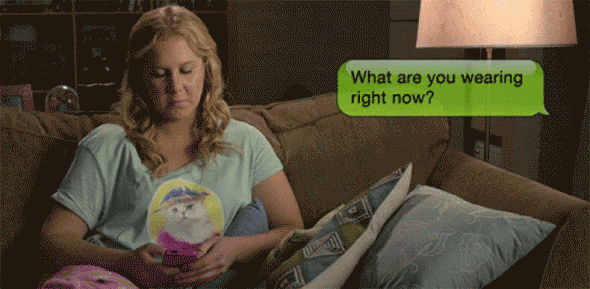In the new season of her show, Amy Schumer’s feminism has gotten blunter. While Season 1 tended to come at feminist issues from askew, with weird, surprising sketches like “clown panties”—in which her boyfriend has an affair with a clown—recent episodes feature clunkier riffs on Hollywood’s gender norms and female empowerment. But as Inside Amy Schumer has evolved, one thing has remained as sharp and subtle as ever: her satire of female fashion. Schumer has always been perceptive about the ways women clothe themselves in various situations, whether as public theater or on their own couch, and about the world’s relentless focus on said clothing. From the “basic” fedora she wears in her sketch about women who can’t accept compliments to the sad little satin cupcake dress in her Toddlers in Tiaras spoof, Amy’s outfits add a sneaky satirical layer to her perspective on how women engage with the world.
Take the sketch “Sexting,” in which she sexts such sizzling banter as “What are you wearing?” “My tit” while wearing a cat T-shirt and pajama pants. She is also eating spaghetti of out a colander with her hands while watching a romantic old movie on television. In this scene, the existential horrors of modern dating are contrasted with the more august trappings of romance in a different time. And nothing captures this tension more pointedly than her get-up. Forget sweeping updos and elegant heels. In the privacy of your own home, armed with only a smartphone, you can wear a cat shirt as a man informs you that he just “came on your hair and head.”
Through her outfits, Schumer neatly establishes a taxonomy of female “types.” In “Raise a Glass,” Amy plays a bridesmaid giving a strangely sing-songy and passive aggressive wedding speech in rhyming couplets for a friend named Becca. She is wearing a blue satin dress with satin flowers up one shoulder like a snake (which is, unfortunately, a very common bridesmaid style). As the scene goes on—and Amy gives more and more passive aggressive rhyming speeches in increasingly terrible situations—the fabric flowers follow her everywhere. At Becca’s funeral, her black mourning dress has a flower roosting on the shoulder. When she’s on trial for Becca’s murder, the flower is there too. Even her orange jail jumpsuit has one. Here, Amy casts the figure of the bridesmaid as a hyper-feminine loon, whose wedding role-playing follows her throughout her life, represented by those creeping fabric flowers.
And, on “Makeover Show,” Amy plays a woman who won a makeover on TV and now refuses to shower or remove any part of her makeover—months after the makeover show is over. For some reason, on any respectable makeover show, the “after” outfit is usually a cardigan and a pencil skirt, a fact that Schumer observes and imitates, vis-a-vis a cardigan and pencil skirt tattered from neglect. Why IS this the best outfit for everyone post-makeover? I guess it is sort of flattering. Regardless, a filthy, unkempt cardigan-and-skirt set is just the right way to send up the central absurdity of makeover shows: the way they take a woman who has her own personal style, for good or for ill, and transform her into a caricature of a ’50s housewife—outfitting her in the uniform of bland, conservative femininity. The ridiculousness of makeover shows is well-documented—it’s nothing SNL hasn’t spoofed before—but in this sketch, it’s the grime-covered business casual outfit that stays with you.
Schumer often approaches her costume choices with a very funny practicality. For instance: the sketch in which she decides to stage a gang bang at her house as a “feminist act” and ends up inviting a bunch of men over, some of whom refuse to gang bang her, which makes her feel unattractive. She therefore insists she must be gangbanged by everyone, a useful comment on how hard it is to subvert the male gaze when so many sexualized female acts are so intrinsic to male approval. (At the end of the skit, many feminist icons’ heads just get blown up). Perhaps the best part: Amy wears a lacy robe and Ugg boots to get gang banged. Ugg boots are expensive, comfortable, and hideous, a status symbol and a symbol of derision, which is a neat mimic of the way the male gaze functions in the skit itself—as something that is at once irresistible and repulsive. Plus, this is a perfect outfit FOR a gangbang, I guess.
Amid the show’s ramped-up, newly heavy-handed feminism, the costumes offer some of the show’s most understated jokes—the kind you could easily miss on first viewing. And they capture the spirit of Inside Amy Schumer at its best: the way the show astutely sends up female pack behavior while mocking the cultural pressures that produce it—the unwritten rules that dictate that bridesmaids wear unflattering, overwrought dresses and serious women who’ve got it together wear pencil skirts. And Inside Amy Schumer’s outfits manages to affectionately skewer feminine tropes while answering, with a semi-straight face, a question that bedevils many a woman: What do I wear? What would one wear to a gangbang? What should one wear while sexting? What does one wear as a contestant on the bachelor? (Jewel tones.) Well, now we know.
